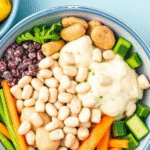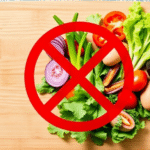Simple Foods to Start a Clean Diet
Starting a clean diet doesn’t have to be complicated or overwhelming. You can achieve this by incorporating a variety of simple foods that are both nutritious and easy to prepare. Here’s a straightforward list of foods to consider as you embark on this journey.
Fruits and Vegetables
Fresh fruits and vegetables are foundational to any clean diet. They are packed with essential vitamins, minerals, and antioxidants. Aim for a colorful variety to maximize your nutrient intake.
- Leafy Greens: Spinach, kale, and Swiss chard are excellent choices. They can be added to salads, smoothies, or cooked as a side dish.
- Berries: Blueberries, strawberries, and raspberries are not only delicious but also high in fiber and antioxidants. Enjoy them as snacks or in yogurt.
- Citrus Fruits: Oranges, grapefruits, and lemons are rich in vitamin C and hydration. They are perfect for snacking or adding a zesty touch to dishes.
- Cruciferous Vegetables: Broccoli, cauliflower, and Brussels sprouts provide fiber and various nutrients. Steaming or roasting these veggies enhances their flavor.
Whole Grains
Whole grains are a great source of energy and fiber. They support digestion and can keep you feeling full longer.
- Brown Rice: This versatile grain can be a base for many meals or served as a side.
- Quinoa: A complete protein, quinoa is easy to cook and can be used in salads or as a side dish.
- Oats: A hearty breakfast option, oats can be customized with fruits, nuts, or seeds.
- Whole Wheat Bread: Look for options with minimal ingredients to make nutritious sandwiches or toast.
Lean Proteins
Including lean proteins in your diet helps with muscle repair and keeps you feeling satisfied.
- Chicken Breast: Skinless chicken is low in fat and high in protein. It can be grilled, baked, or roasted.
- Fish: Salmon, tuna, and mackerel are rich in omega-3 fatty acids and can boost heart health.
- Tofu: A plant-based protein, tofu absorbs flavors well. It’s a great addition to stir-fries or salads.
- Legumes: Beans, lentils, and chickpeas are loaded with protein and fiber. Use them in soups, stews, or tacos.
Nuts and Seeds
Nuts and seeds offer healthy fats, protein, and fiber, making them perfect for snacks or toppings.
- Almonds: A handful of almonds can provide a satisfying snack packed with nutrients.
- Chia Seeds: These tiny seeds expand in liquid, creating a nutritious pudding or addition to smoothies.
- Sunflower Seeds: They add crunch to salads or snacks and are a source of vitamin E.
- Walnuts: These nuts are high in omega-3 fatty acids and can be sprinkled on oatmeal or yogurt.
Healthy Fats
Healthy fats is essential in a clean diet as it aids in nutrient absorption and provides energy.
- Avocado: Creamy and versatile, avocados can be spread on toast or added to salads and smoothies.
- Olive Oil: Use extra virgin olive oil for salad dressings or cooking. It’s full of good fats.
- Coconut Oil: Great for cooking and baking, coconut oil can add flavor and nutrients.
Simple Preparations
When starting a clean diet, how you prepare your foods matters as much as what you choose to eat. Here are some easy cooking methods to keep in mind:
- Steaming for vegetables to retain their nutrients.
- Grilling lean meats for a smoky flavor without added fat.
- Roasting for a rich, hearty texture, especially for vegetables and whole grains.
- Batch cooking to save time on meal prep throughout the week.
Transitioning to a clean diet is achievable when you stick to simple, whole foods. By choosing fresh fruits, vegetables, whole grains, lean proteins, nuts, seeds, and healthy fats, you’ll build a nutritious framework for your meals. For more detailed guidance, you can visit Eat Clean for recipes and meal plans that support a clean eating lifestyle.
Remember, the journey to healthier eating is about making informed choices that work for you. Every small step in changing what you eat can lead to a healthier and happier you!
Benefits of Eating Whole Foods
Eating whole foods has gained considerable attention in recent years, and for good reason. These foods bring a multitude of benefits that can positively impact your overall health and well-being. Whole foods are those that are minimally processed and free from artificial ingredients, preservatives, and added sugars. They include fruits, vegetables, whole grains, legumes, nuts, and seeds.
Improved Nutrient Intake
Whole foods are rich in essential nutrients. They contain vitamins, minerals, fiber, and antioxidants that support your body’s functions. Unlike processed foods, which may lose some nutrients during manufacturing, whole foods provide a robust selection of nutrients in their most natural form.
Examples of Nutrient-Rich Whole Foods:
- Fruits: Apples, berries, oranges
- Vegetables: Spinach, broccoli, carrots
- Whole grains: Brown rice, quinoa, oats
- Nuts and seeds: Almonds, chia seeds, walnuts
Better Weight Management
Choosing whole foods can aid in weight management. They are typically lower in calories and higher in fiber than processed foods, making you feel fuller longer. This can prevent overeating and reduce cravings. Furthermore, whole foods generally have healthier fat and carbohydrate profiles, contributing to better decision-making regarding your dietary habits.
Filling Whole Food Options:
- Whole grain oatmeal topped with fresh fruit
- Salads packed with a variety of colorful vegetables
- Homemade bean and vegetable soups
Enhanced Digestive Health
Whole foods are excellent for digestive health. They are high in dietary fiber, which helps keep your digestive system running smoothly. Fiber aids in regular bowel movements, improves gut health, and can even prevent certain gastrointestinal disorders. When you incorporate whole foods into your diet, you’re providing your gut with the support it needs.
Fiber-Rich Whole Foods:
| Food | Fiber Content per Serving |
|---|---|
| Chia Seeds | 10g |
| Oats | 4g |
| Lentils | 15g |
| Broccoli | 5g |
Lower Risk of Chronic Diseases
By consuming whole foods regularly, you can lower your risk of developing chronic diseases such as heart disease, diabetes, and certain cancers. Whole foods contribute to overall heart health by providing healthy fats, fiber, and antioxidants. They help to manage blood sugar levels, making it easier to control diabetes risk.
Key Benefits for Disease Prevention:
- Reduction in cholesterol levels
- Stabilization of blood sugar
- Improved blood pressure
Increased Energy Levels
Whole foods often provide a steady source of energy. Because they are rich in complex carbohydrates and fiber, they release energy slowly. This slow release helps sustain energy levels throughout the day, preventing those dreaded energy crashes that often come after consuming refined sugars and processed foods.
Whole Food Energy Sources:
- Brown rice
- Quinoa
- Sweet potatoes
Greater Variety and Flavor
Whole foods often exhibit a range of colors and textures, making meals more visually appealing and flavorful. This variety can encourage you to experiment in the kitchen, trying out new recipes and combinations that can expand your culinary horizons. Whole foods, when cooked or prepared properly, can be both delicious and satisfying.
Creative Whole Food Meal Ideas:
- Quinoa salad with fresh vegetables and herbs
- Roasted sweet potato and black bean tacos
- Stir-fried broccoli with cashews
Making the shift to a whole food diet can be an impactful decision for your health. To begin, you might consider visiting resources like Eat Whole Foods and Whole Foods Market for further information and inspiration on incorporating these beneficial foods into your daily meals. By focusing on whole foods, you can enjoy a healthier lifestyle filled with vitality, energy, and well-being.
How to Build Balanced Meals with Clean Ingredients
Creating balanced meals with clean ingredients is a simple yet effective way to nourish your body and boost your overall health. Understanding how to combine various food groups will not only help you feel fueled but also keep your meals exciting and flavorful. Here’s how you can build delicious, balanced meals using clean ingredients.
Understanding Clean Ingredients
Clean ingredients typically refer to whole foods that are minimally processed and free from artificial additives. These include:
- Fresh fruits and vegetables
- Whole grains like brown rice and quinoa
- Lean proteins such as chicken, fish, legumes, and eggs
- Healthy fats including avocados, nuts, and olive oil
- Natural seasonings like herbs and spices
Balancing Your Plate
A balanced meal should include a combination of macronutrients: carbohydrates, proteins, and fats. Follow these steps to construct your plate:
1. Fill Half Your Plate with Vegetables and Fruits
Vegetables and fruits are vital for providing essential vitamins, minerals, and dietary fiber. Aim for a colorful variety to ensure a wide range of nutrients. Some great options include:
- Leafy greens like spinach or kale
- Cruciferous vegetables such as broccoli and cauliflower
- Fruits like berries, apples, and oranges
2. Include a Source of Protein
Protein is critical for muscle repair and overall health. Choose clean proteins that fuel your body, such as:
- Grilled or baked chicken breast
- Salmon or another high-quality fish
- Plant-based options like lentils or chickpeas
3. Choose Whole Grains
Whole grains offers sustained energy and important nutrients. Here are a few clean options:
- Quinoa
- Brown rice
- Oats
4. Add Healthy Fats
Healthy fats are essential for nutrient absorption and heart health. Include these in your meal:
- Olive oil for dressing or cooking
- Avocado, either sliced or mashed
- Nuts or seeds sprinkled on salads or bowls
Example Meal Combinations
Here’s how you can put it all together. Below are examples of balanced meals utilizing clean ingredients:
| Meal Type | Example Combinations |
|---|---|
| Breakfast | Oatmeal topped with fresh berries and a drizzle of honey |
| Lunch | Grilled chicken salad with mixed greens, cherry tomatoes, cucumber, and olive oil dressing |
| Dinner | Quinoa bowl with baked salmon, steamed broccoli, and sliced avocado |
Snack Ideas
Snacking can also be part of a clean diet. Opt for simple options that satisfy hunger and deliver nutrition:
- Apple slices with almond butter
- Greek yogurt with a sprinkle of mixed seeds
- Carrot sticks with hummus
Making It a Lifestyle
Building meals with clean ingredients is not just a short-term fix but a lifestyle choice. Start with small changes, and gradually incorporate more clean ingredients into your diet. Visit Eat Clean for helpful resources and recipes to inspire your meal planning. With practice, you will find it easier to create meals that are nutritious, tasty, and satisfying.
Remember, the aim is to enjoy your food while nourishing your body with the nutrients it needs. Spend time experimenting with flavors and combinations to discover what works for you.
Meal Prep Ideas for a Clean Eating Lifestyle
Meal prep can be a game changer for anyone aiming to adopt a clean eating lifestyle. By preparing meals in advance, you save time, reduce stress during busy weekdays, and ensure that healthy options are always available. Here are some effective meal prep ideas that will support your clean eating goals and make your week healthier and more manageable.
Plan Your Menu
Start by planning your menu for the week. Consider your favorite clean foods and how you can incorporate them into balanced meals. Aim for a mix of proteins, healthy fats, and carbohydrates. Here’s a simple menu template you can follow:
- Breakfast: Overnight oats or smoothie bowls
- Lunch: Quinoa salad with mixed vegetables and grilled chicken
- Dinner: Baked salmon with sweet potatoes and steamed broccoli
- Snacks: Mixed nuts, Greek yogurt, or sliced veggies with hummus
Batch Cooking Proteins
Cooking proteins in bulk is one way to ensure you have quick and easy sources of nutrition available. Here are a few ideas:
- Grilled Chicken: Marinate and grill several chicken breasts, which can be used in wraps, salads, or as a main dish.
- Hard-Boiled Eggs: Boil a dozen eggs in advance for quick snacks or breakfast options.
- Ground Turkey or Beef: Brown several pounds to use in tacos, stir-fries, or mixed with veggies.
Prepare Healthy Grain Options
Grains provide energy and should be a staple in your meal prep. Prepare them in advance to make meal assembly easier:
- Quinoa: Cook a large batch and store it in the refrigerator to use throughout the week.
- Brown Rice: Easy to cook large quantities, perfect for stir-fries or as a base for bowls.
- Oats: Cook steel-cut oats and portion them for a hearty breakfast that you can customize.
Chop and Store Vegetables
Chopping vegetables can be time-consuming. Take some time to prepare them all at once:
- Veggie Packs: Create snack packs with carrot sticks, cucumber slices, and bell pepper strips.
- Dice for Salads: Chop tomatoes, cucumbers, and onions ahead of time for easy salad assembly.
- Stir-Fry Mixes: Blend a variety of vegetables that can be quickly sautéed for a nutritious meal.
Make Healthy Sauces and Dressing
Homemade sauces and dressings can elevate your meals. Prepare a few in advance to keep your dishes exciting:
- Vinaigrette: Mix olive oil, balsamic vinegar, mustard, and herbs for a light dressing.
- Homemade Hummus: Blend chickpeas, tahini, lemon juice, and garlic for a nutritious dip.
- Salsa: Dice tomatoes, onions, cilantro, and add lime juice for a fresh topping.
Use Proper Storage Methods
To make the most of your prep efforts, store food properly:
- Glass Containers: Opt for durable glass containers that are microwave-safe and airtight.
- Meal-Sized Portions: Pre-portion your meals into single servings for easy grab-and-go access.
- Label and Date: Use labels to keep track of what you have prepared and when it was made.
Healthy Snacks On Hand
Having healthy snacks ready is crucial to avoid reaching for unhealthy options. Consider these:
- Energy Bites: Make no-bake energy balls with nuts, seeds, oats, and a sweetener.
- Nut Butter Packs: Portion nut butter with apple slices or whole-grain crackers.
- Greek Yogurt Parfaits: Layer yogurt with fruits and nuts for a satisfying snack.
Meal prepping can significantly align with your clean eating goals. By planning and preparing meals in advance, you can maintain healthy eating habits more easily. For more meal prep ideas, tips, and tricks, visit Eat Clean or Clean Eating Magazine.
Overcoming Challenges When Transitioning to Clean Eating
Transitioning to clean eating can be an exciting yet challenging journey. Many people face obstacles during this process, but with the right strategies, these challenges can become manageable. Below are some common challenges you might encounter, along with tips to effectively overcome them.
Emotional and Psychological Barriers
One of the first challenges faced when adopting a clean eating lifestyle is dealing with emotional and psychological barriers. Food is often tied to our emotions, and changing your diet may trigger cravings for comfort foods that are typically unhealthy. To combat this, try these strategies:
- Practice Mindful Eating: Focus on your food, enjoy each bite, and recognize your body’s hunger cues.
- Find Healthy Substitutes: Instead of reaching for sugary snacks, consider fruit or nuts. This can help satisfy cravings without derailing your goals.
- Seek Support: Connect with friends, family, or online communities. Talking about your goals can bolster motivation and accountability.
Understanding Clean Eating
Another hurdle is understanding what clean eating truly means. Some people get confused by the various definitions and find it hard to know where to start. Here’s a simple breakdown to clarify clean eating:
| Food Group | Examples |
|---|---|
| Whole Grains | Quinoa, brown rice, whole wheat pasta |
| Fruits & Vegetables | Spinach, apples, berries, carrots |
| Proteins | Chicken, fish, beans, lentils |
| Nuts & Seeds | Almonds, chia seeds, walnuts |
Being clear about what foods fit into the clean eating category can simplify meal planning and grocery shopping.
Social Situations
Social situations can pose significant challenges. Dining out, attending gatherings, or sharing meals with friends can make it difficult to stick to a clean eating plan. Here’s how to navigate these scenarios:
- Plan Ahead: If you know you’re going out, check the menu beforehand and choose clean options.
- Don’t Be Afraid to Voice Your Needs: Let friends or family members know your goals. They may offer dishes that cater to your clean eating plan.
- Bring Your Own Dish: At potlucks or gatherings, contribute a clean dish that you know you can enjoy.
Transitioning to clean eating is about making small, sustainable changes. Remember that it’s okay to slip up occasionally. Each meal is an opportunity to start anew.
Meal Planning and Preparation Challenges
Another significant hurdle involves meal planning and preparation. With a busy lifestyle, it can be difficult to find time to cook. Consider these strategies:
- Batch Cooking: Prepare large portions of clean meals on weekends so you have ready-to-eat options during the week.
- Use a Meal Prep Service: If cooking feels overwhelming, consider a meal prep service that specializes in clean eating options to simplify the process.
- Invest in Tools: Invest in essential kitchen tools like a slow cooker or an instant pot to make preparation easier.
Transitioning to a clean eating lifestyle offers numerous health benefits. By recognizing the challenges and implementing effective strategies, you can make a smoother shift to healthier eating habits. For additional resources and guidance, consider checking out Eat Clean or The Kitchn.
The Role of Hydration in a Clean Diet
Staying hydrated is often overlooked when it comes to following a clean diet. However, understanding the role of hydration can significantly enhance your journey towards a healthier lifestyle. Proper hydration can transform your diet from simple to effective, making it easier to achieve your wellness goals. Here, we’ll explore how hydration contributes to a clean diet, along with practical tips to ensure you are drinking enough fluids.
Water is essential for numerous bodily functions, including digestion, nutrient absorption, and waste elimination. By integrating adequate hydration into your clean diet, you can enhance your overall health and well-being. Here are several key roles of hydration:
- Boosting Metabolism: Hydration can help maintain an efficient metabolic rate. Studies have shown that drinking water can temporarily boost the number of calories you burn, aiding weight management.
- Enhancing Digestion: Drinking enough fluids assists in the breakdown of food and nutrient absorption. A well-hydrated body improves the function of enzymes and helps to soften stool, reducing the risk of constipation.
- Improving Skin Health: Proper hydration can lead to a clearer complexion. When you drink enough water, your skin has a healthier appearance, reducing dryness and promoting elasticity.
- Regulating Appetite: Hydration can often be confused with hunger. Sometimes when you feel hungry, it’s actually your body requesting hydration. Drinking water before meals can help you manage portions more effectively.
- Supporting Healthy Muscle Function: Staying hydrated is crucial for muscle recovery and function. Dehydration can lead to muscle cramps and fatigue, making it essential for those looking to maintain a clean diet and active lifestyle.
Hydration into your daily routine doesn’t have to be complicated. Here are some practical tips you can follow:
- Start Your Day with Water: Begin each day by drinking a glass of water. This not only hydrates you after a night of sleep but also kickstarts your metabolism.
- Infuse Your Water: If plain water doesn’t excite you, try adding fruits or herbs for flavor. Lemon, cucumber, and mint are great options that can make drinking water more enjoyable.
- Carry a Water Bottle: Having a reusable water bottle with you can remind you to drink throughout the day. Aim for at least eight glasses (or about two liters) of water a day as a general guideline.
- Eat Water-Rich Foods: Incorporate fruits and vegetables with high water content, such as cucumbers, watermelon, strawberries, and spinach, into your meals for additional hydration.
- Set Reminders: Use your phone or watch to set reminders to drink water, especially if you tend to forget during busy days.
Considering the daily intake of fluids has a critical role in a clean diet, it’s also essential to understand how this interacts with your overall nutrition. Here’s a quick comparison highlighting the effects of various drinks:
| Drink | Hydration Level | Nutritional Benefits | Tips |
|---|---|---|---|
| Water | High | No calories, essential for hydration | Plain, infused, or sparkled |
| Fruit Juice | Moderate | Vitamins, but high in sugars | Dilute with water |
| Soda | Low | High in sugar, no nutritional value | Avoid or limit intake |
| Herbal Tea | High | Anti-inflammatory properties | Unsweetened varieties are best |
It’s vital to listen to your body and drink when you are thirsty; however, being proactive can yield even greater benefits. By prioritizing hydration, you can support your clean diet and overall health goals. Additionally, consider resources such as National Institutes of Health for insights into the importance of hydration in a healthy lifestyle.
Simple hydration strategies into your clean diet can pave the way for a healthier you. Make water your best friend, and watch how it enhances your overall diet and wellness journey.
Recipes Using Simple Ingredients for Clean Eating
Eating clean doesn’t have to be complicated or overwhelming. By focusing on simple ingredients, you can whip up delicious meals that nourish your body and satisfy your taste buds. Below, you’ll find some easy recipes that utilize simple ingredients, making clean eating accessible for everyone.
Breakfast Ideas
Starting your day with a wholesome breakfast sets a positive tone. Here are a few recipes that use simple, clean ingredients:
- Overnight Oats: Combine rolled oats, almond milk, and your choice of toppings like bananas, honey, or chia seeds. Let it sit in the fridge overnight for a quick morning meal.
- Veggie Omelette: Whisk together eggs and add spinach, tomatoes, and bell peppers. Cook in a non-stick skillet for a hearty breakfast.
- Green Smoothie: Blend together spinach, banana, almond milk, and a scoop of peanut butter for a nutrient-packed start to your day.
Lunch Recipes
For lunch, quick and clean meals can keep you focused and energized throughout the day. Try these simple recipes:
- Quinoa Salad: Cook quinoa and toss it with cherry tomatoes, cucumbers, cilantro, lime juice, and olive oil. This refreshing salad is perfect for meal prep.
- Grilled Chicken Wrap: Grill a chicken breast and slice it into strips. Wrap it in a whole-grain tortilla with mixed greens, avocado, and a smear of hummus.
- Lentil Soup: Simmer lentils with diced carrots, onions, and celery in vegetable broth for a warm and filling meal.
Dinner Options
Dinner can be just as simple yet fulfilling. Here are some clean eating dinner ideas:
- Baked Salmon: Season salmon fillets with lemon juice, garlic, and herbs. Bake at 375°F for about 15-20 minutes. Serve with steamed broccoli.
- Stir-Fried Vegetables and Tofu: Cube tofu and sauté with bell peppers, snow peas, and carrots in a splash of soy sauce.
- Stuffed Peppers: Hollow out bell peppers and fill with a mixture of brown rice, black beans, corn, and salsa. Bake until the peppers are tender.
Snack Ideas
Snacking clean can be just as enjoyable. Here are easy snacks using everyday ingredients:
- Vegetable Sticks with Hummus: Cut carrots, celery, and cucumbers into sticks and dip them in hummus for a boost of fiber and protein.
- Greek Yogurt with Honey and Berries: Top a bowl of plain Greek yogurt with fresh berries and a drizzle of honey for a sweet treat.
- Rice Cakes with Almond Butter: Spread almond butter on rice cakes and top with banana slices for a satisfying crunch.
Batch Cooking for Easy Meal Prep
To make clean eating even easier, consider batch cooking some of these meals. Here’s a simple plan:
| Day | Meal | Ingredients |
|---|---|---|
| Monday | Quinoa Salad | Quinoa, cherry tomatoes, cucumbers, olive oil |
| Tuesday | Lentil Soup | Lentils, carrots, onions, vegetable broth |
| Wednesday | Veggie Omelette | Eggs, spinach, tomatoes, bell peppers |
| Thursday | Stuffed Peppers | Bell peppers, brown rice, black beans, corn |
| Friday | Baked Salmon | Salmon fillets, lemon, garlic, herbs |
By preparing these meals in advance, you can enjoy clean eating throughout your week with minimal effort. For more recipes and resources about clean eating, visit Eating Well or Cookie and Kate.
Clean eating is all about choosing simple, wholesome ingredients for better health. With these recipes, preparing nutritious meals is easy, as well as enjoyable. Start your clean eating journey today!
Key Takeaway:
A clean diet is a powerful way to promote health and well-being, and embracing simple foods is an essential first step in this journey. To effectively start a clean diet, focus on incorporating whole, unprocessed options such as fruits, vegetables, whole grains, lean proteins, and healthy fats. These simple foods not only provide your body with vital nutrients but also play a significant role in boosting your energy levels and improving your mood. The benefits of eating whole foods cannot be overstated; they are usually high in fiber, vitamins, and minerals while being low in refined sugars and unhealthy fats, which can lead to better digestion and lower the risk of chronic illnesses.
Building balanced meals is crucial when transitioning to a clean diet. This means including a variety of food groups on your plate, ensuring that you obtain a wide range of nutrients. A balanced meal might include brown rice, grilled chicken, and steamed broccoli. Focusing on the quality of your ingredients not only enhances flavor but also contributes to a healthier lifestyle. Meal prep is a vital strategy for maintaining a clean eating lifestyle. Planning and preparing your meals in advance can save you time and help you resist the temptation to opt for unhealthy convenience foods during a busy week.
Transitioning to clean eating can come with its challenges, such as cravings for processed foods or difficulty in finding time to prepare meals. However, being mindful of your hydration needs is equally important. Drinking plenty of water can help curb your appetite and aid digestion, making it easier to stick to your clean eating plan. Don’t forget about incorporating simple recipes using fresh ingredients to make your clean meals exciting and enjoyable. By experimenting with flavors and cooking techniques, you can discover wholesome dishes that delight your taste buds without straying from your clean diet goals.
Starting a clean diet with simple foods sets a solid foundation for a healthier lifestyle. By embracing whole foods, creating balanced meals, preparing in advance, staying hydrated, and enjoying delicious recipes, you can overcome challenges and build a sustainable plan that supports your health journey. Clean eating not only transforms what you eat, but it also enhances your overall quality of life.
Conclusion
Adopting a clean diet is not just about choosing simple foods; it’s about cultivating a sustainable lifestyle that benefits your health and well-being. The advantages of eating whole foods are numerous, offering vital nutrients that can improve your energy levels, enhance your mood, and support overall bodily functions. By focusing on clean ingredients, you can easily create balanced meals that nourish both your body and mind.
Meal prepping can be a game changer on your journey to clean eating. It saves time, reduces stress during busy days, and ensures that you always have healthy options readily available. Embracing meal prep allows you to explore various recipes that utilize simple ingredients, making healthy eating both enjoyable and achievable.
Transitioning to a clean diet may come with its challenges. However, by planning ahead and being mindful of your choices, you can successfully navigate these obstacles. Remember that you’re not alone; many are embarking on this journey alongside you. Celebrate small victories as they will motivate you to keep moving forward.
Equally essential is the role of hydration in supporting a clean diet. Drinking adequate water not only helps with digestion but also supports your body in absorbing all the nutrients from the wholesome foods you consume.
As you incorporate these simple foods and strategies into your daily routine, pay attention to how your body responds. You may find that feeling better, having more energy, and enjoying food becomes a natural part of your life. Keep experimenting, stay mindful, and allow yourself to relish the journey to a healthier, cleaner lifestyle.












